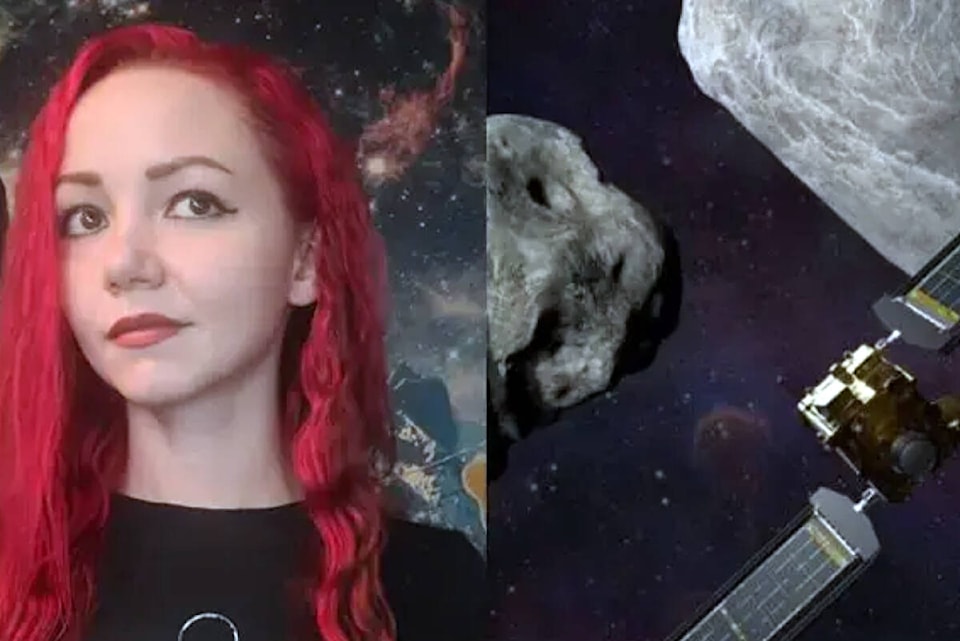There may come a day, if the Earth is struck by an asteroid, that an alien race observing the collision won’t be able to say, “They never knew what hit ‘em.”
Then again, a recent space mission has proven it’s possible to divert an asteroid’s or comet’s collision with Earth.
Jennie King, a NASA-JPL solar system ambassador, will talk about the double asteroid redirection test – an historic first attempt to divert an asteroid’s path through space by ramming it with a spacecraft travelling thousands of kilometres per hour – when she presents ‘Defending the Earth, One Cosmic Crash Test at a Time’ at the Nanaimo Astronomy Society’s next meeting.
King is a graduate of University of Virginia’s astronomy program, where she discovered her love for science, technology, engineering and mathematics education and outreach. She brought her enthusiasm for space exploration to advanced physics and engineering classrooms in Aurora, Colo., and became a solar system ambassador to encourage others to explore the wonders of the cosmos.
King moved to the Lower Mainland recently and she plans to continue connecting with astronomy and STEM education communities.
“The solar system ambassador program is basically a public network of volunteers who go out to communicate the excitement of what NASA does, in terms of the science and the space exploration and the missions that are happening,” King said. “I have always been a big space enthusiast since I was a child. I ended up studying astronomy, of course, and I truly think that there’s nothing that really has the potential to inspire like space and space exploration do … Now I get to go forth and do what is my favourite thing to do, which is talk to people about how cool this stuff is and what it does for us here on Earth.”
An example is the DART mission, which could lead to being able to prevent an asteroid or comet from destroying a city or worse.
The experiment involved crashing a small space probe into Dimorphos, an asteroid moonlet roughly 160 metres in diameter that orbits Didymos, the larger 780-metre asteroid of the binary pair.
The pair orbit around the sun along a path that in 2003, brought it within about seven million kilometres of Earth. While NASA says Dimorphos and Didymos are not at threat to our planet, they are considered to be of a size of asteroid or comet that, should it hit a city on Earth, would cause wide-scale destruction.
The DART spacecraft was launched from Vandenberg Space Force Base in California last November and impacted Dimorphos this past September at a speed of about 6.6 kilometres per second at a distance of about 11 million kilometres from Earth.
“It would be something to the effect of throwing a vending machine at one of the Great Pyramids, in terms of the size,” King said. “You could also say, maybe, it’s like crashing a bus into a sports stadium full of rocks … That’s kind of the relative size of things.”
She said there was no chance of the impact redirecting the asteroid toward Earth – for that to happen, “physics would have to be broken.”
But the goal of the experiment was to change the speed of Dimorphos’ orbit around Didymos and the tiny DART craft did make a sizeable impression. Dimorphos’ orbit around Didymos, prior to the collision, took 11 hours, 55 minutes, and the post-impact orbit is now 11 hours, 23 minutes. The minimum orbit change established for the experiment to be considered a success was 73 seconds and DART exceeded that minimum by 25 times, according to NASA’s figures.
“People were saying we would consider it an astounding success if we were changing its orbit by about 10 minutes … which shows that this is a pretty useful technology for this type of asteroid deflection,” King said.
She also commented on the technology built into the DART spacecraft and said during its final approach it navigated autonomously into the asteroid.
“We had never actually seen the smaller of the two asteroids,” she said. “We’d never seen it with human eyes before until the spacecraft got there, used its own onboard technology and imaging system to say, ‘OK, that’s the smaller one. I see it now and I will crash myself into it.’”
Nanaimo Astronomy Society’s next meeting happens, Thursday, Nov. 24, from 7-9 p.m. at the Beban Park social centre and on Zoom for paid members. Non-members are welcome to attend one free meeting and are then encouraged to join the society. For more information, visit www.nanaimoastronomy.com.
chris.bush@nanaimobulletin.com
Like us on Facebook and follow us on Twitter
